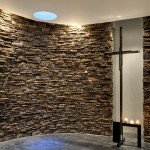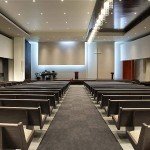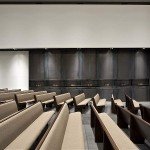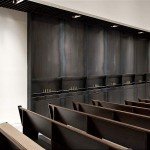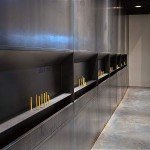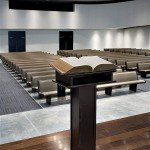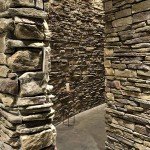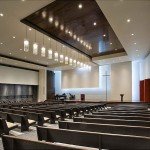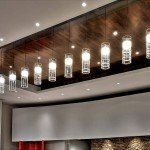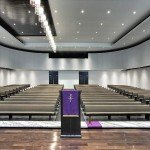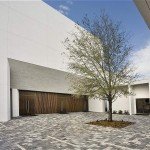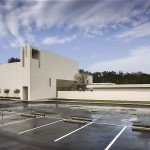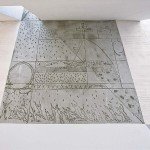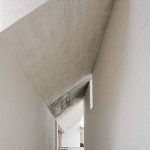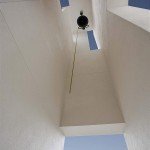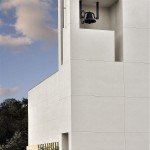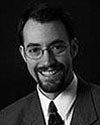 By Rodney Shores
By Rodney Shores
Rodney Shores (D.W.S., Zeta 2005) serves as Pastor of Worship and the Arts at Tampa Covenant Church (Tampa, Florida), Assistant Professor of Worship Ministries at Trinity College of Florida (New Port Richey), and director of Voce di Vita, Le Petit Choeur, and Mannchor of the Gulf Coast Youth Choirs (Tampa).
In January of 2002, I began the D.W.S. program at the Robert E. Webber Institute for Worship Studies. By June of that year, the congregation of Tampa Covenant Church, where I serve as Pastor of Worship and the Arts, had decided that it was time to construct a new worship space on their existing property. Directly influenced by the inspiration and fresh discoveries I was gaining at IWS, particularly through Professors Constance Cherry and Mark Torgerson in the “Music and the Arts” course, the building committee set to work attempting to implement an architecture and subsequent structure that would incorporate their theological sensitivities in the actual physicality of the space on a shoestring budget.
After several months of meetings, theological discussions, mock-ups, and brainstorming sessions, the team realized they were getting nowhere. That’s when the miracle happened. A couple of very humble architects began to attend worship services—Albert Alfonso and Angel del Monte from the prestigious Alfonso Architects firm in Ybor City, Florida. Given their passion for sacred architecture, they soon joined the building committee, which started from scratch. The design and building process continued simultaneously as the foundation was poured and the cost-effective pre-fab steel framing was erected, becoming the “box” the architects had to work with.
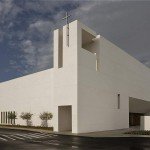 Needless to say, the creative genius and financial wisdom of the gentlemen from the Alfonso firm along with the theological detailing of the pastoral and elder staff came to fruition. The new sanctuary was dedicated January 3, 2010.
Needless to say, the creative genius and financial wisdom of the gentlemen from the Alfonso firm along with the theological detailing of the pastoral and elder staff came to fruition. The new sanctuary was dedicated January 3, 2010.
The notes below explain the theological intentionality of the space, and reflect our desire for the environment to form the gospel of Christ within the parishioners. Click on the pictures to see the full-sized versions.
Nature
First, the committee desired to reflect the non-gnostic truth that God’s creation is holy: though mankind fell into sin, creation groans, waiting for the sons and daughters of God to be revealed at the great consummation of all creation. Elements of nature were deliberately included in the space, signifying that creation finds its true redemption in the redemption of God’s sons and daughters.
Elements of nature were deliberately included in the space, signifying that creation finds its true redemption in the redemption of God’s sons and daughters.
The Church as koinōnia relates also to the animal and material world as a whole. Perhaps the most urgent mission of the Church today is to become conscious of and to proclaim in the strongest terms the fact that there is an intrinsic communion between the human being and its natural environment, a communion that must be brought into the Church’s very being in order to receive its fullness. –John Zizioulas
Zizioulas, John. “The Church as Communion,” St. Vladimir’s Theological Quarterly 38:1 (1994): 13.
Further, the beauty of the Golden Ratio—the proportion found throughout nature (human physical proportions demonstrated in Da Vinci’s Vitruvian Man, conch shells, etc.)—was deliberately employed in the design of the chancel area, as is apparent by the position of the forward wall, the cross, and the empty tomb (or “red scoop”) on the right. Likewise, the chapel, adjacent to the right wall of the sanctuary, reflects the ratio in its spiral design.
Natural light was also a requisite inclusion, as God’s light permeates the darkness of our fallen creation. This is seen most obviously in the light that emanates from behind the forward wall on the left of the chancel as well as from behind the cross on the right. Further, a beam of light shines through a skylight above and near midday accents the cross. There is also a skylight in the chapel, again signifying God’s presence among His people.
Additionally, the committee deliberately included natural light in the form of a candle wall on the left, designed and constructed from steel for TCC’s sanctuary. This space is used specifically for services of light, during Lent, Holy Week, Advent, and the Christmas season. Moreover, each service features an individual candle in each of the seven candle boxes (though, theoretically, the candle boxes could hold hundreds of thin, dripless candles).
Wood was intentionally included (the floor, certain walls of the chancel, and the ceiling over the chandeliers), and also stone (the chapel, both inside and out).
Ultimately, the entire worship space was a deliberate attempt to represent an “Ancient-Future” approach to the design of the space (though not in its truest sense, per Webber). One senses that a very old chapel already existed and a new contemporary sanctuary was constructed around it in order to maintain a connection with the history of the Church and its fathers.
God as Triune
The sanctuary was designed to symbolically represent the three persons of the Trinity with Christ at the center.
Jesus
The cross and empty tomb (red scoop) occupy a prominent place at the right of the chancel, visually representing the death and resurrection of our Lord. Fourteen chandeliers point to the cross. Members of the building committee are especially thrilled with the dual meanings of these chandeliers. First, they represent the fourteen biblical Stations of the Cross (adjusted by Pope John Paul II and celebrated first on Good Friday, 1991). Second, beginning from the back of the sanctuary to front, each chandelier is etched with an individual set of rings which, when laid over the melodic score, notate the first fourteen pitches of the hymn “O Sacred Head, Now Wounded.”
Then, through the mediation of Christ, God meets His people at word and Table, nurturing them through the scripture and sacrament.
The Father
The candlebox represents the eternal presence of the Father in creation, light, and fire. Additionally, the seven compartments represent the ever-creating nature of God through the seven days of creation.
The Holy Spirit
The prayer chapel represents the Holy Spirit and His intercession on behalf of His people, revealed in the skylight piercing the internal darkness of the chapel and the spiral construction (the Golden Ratio) which envelops worshipers in God’s presence and draws them into the movement of the Holy Spirit in their lives. Additionally, the stones are representative of believers, the living stones of the church, held together by the Holy Spirit.
Exterior
The exterior of the worship space is also intentional. First, the courtyard is a gathering space for God’s people (in addition to the narthex). The courtyard marks the gathering of God’s people as community, God’s people gathered for worship, fellowship, and education (the adjacent buildings, middle and right). A permanent baptistery is planned for the courtyard in the future. The location of baptismal water in the entry space will serve to remind worshipers of their baptismal vows as they enter the sanctuary.
The bell-tower marks God’s Kingdom of Peace, His Shalom, rising up over all the earth. The bell is rung at the beginning and end of each service as well as during special seasons and high holy days. A hand-etched tableau that summarizes the story of God occupies the subtle space of the tower, creating a striking image as one passes into the sanctuary.
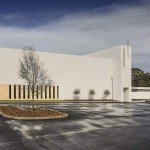 Additionally, there are twelve office windows (apostles, tribes) on the front of the building, and three olive trees to their right, symbols which elicit many Old and New Testament ideas, primarily the Trinity.
Additionally, there are twelve office windows (apostles, tribes) on the front of the building, and three olive trees to their right, symbols which elicit many Old and New Testament ideas, primarily the Trinity.
There are numerous less significant “touches” that are too many to mention in this article.
Conclusion
Tampa Covenant Church is eternally grateful for our generous congregation, the leadership of the building committee, elders, pastors Eric Meyer and Lou Kaloger, and especially Alfonso Architects, Angel del Monte and Albert Alfonso. Ultimately, we are grateful for the vision of Robert Webber and the influence of the Robert E. Webber Institute for Worship Studies, particularly professors Mark Torgerson and Constance Cherry. The new sanctuary is testament to the worship renewal envisioned and inspired by Robert Webber.
Now unto the King eternal, immortal, invisible, the only wise God, be honor and glory forever and ever. Amen (1 Tim 1:17).

 Zizioulas, John. “The Church as Communion,” St. Vladimir’s Theological Quarterly 38:1 (1994): 13.
Zizioulas, John. “The Church as Communion,” St. Vladimir’s Theological Quarterly 38:1 (1994): 13.
